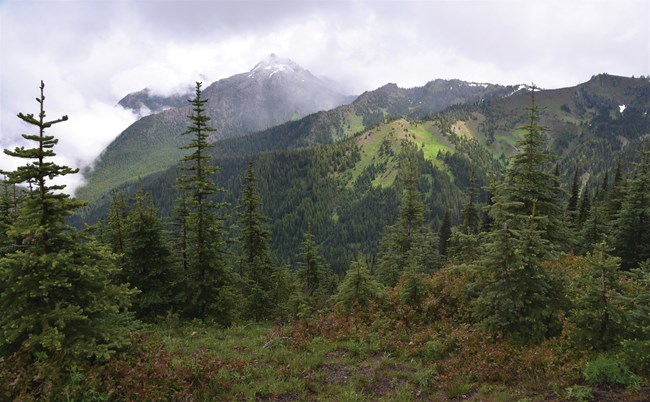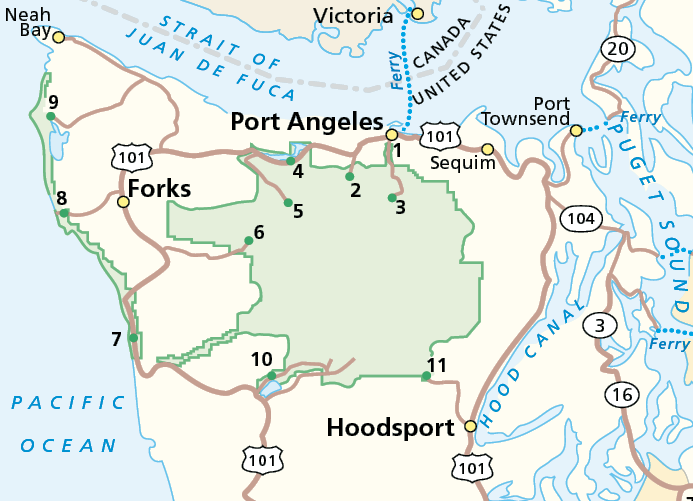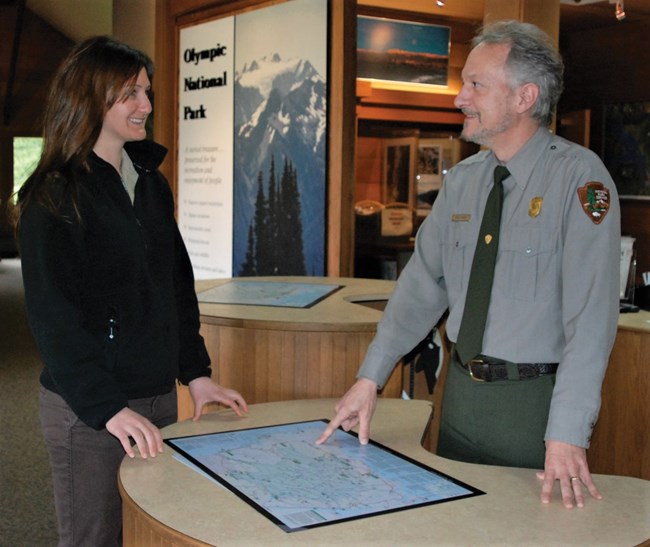
Photo by M. Juran/NPS When Goats Fly: Finding Balance in Mountain Habitats“Goats Addicted to Human Urine Airlifted Out of National Park.” Variations of this headline spread around the world as news outlets picked up the story of Olympic’s mountain goat translocation in September 2018. Wildlife biologists and others familiar with the details of the project shook their heads and chuckled at this colorful take on a complex issue.In their native range, mountain goats are irresistibly drawn to naturally salty minerals. But in the Olympic Mountains, where mountain goats are not native, there are no natural salt licks. In fact, the saltiest thing in the Olympics might be people! Human sweat and urine are salty, and whether it’s a trailside pit stop or a pair of sweaty socks hung up to dry, mountain goats crave salt. Hikers and park staff have reported numerous occasions when aggressive goats followed them for miles, approached them and even attacked. Clearly, habituated mountain goats pose a danger to humans, which is not to be taken lightly. However, risk to human safety is not, on its own, a reason to remove a species from a national park. All wildlife is potentially dangerous. Because mountain goats are not a native species, their presence in the Olympics is at odds with the National Park Service mandate to manage ecosystems as closely as possible to a natural state. With its diverse ecosystems and unique species, Olympic National Park is a World Heritage site and a biosphere reserve. Geographic barriers isolating the Olympic Peninsula have made it an exceptionally unique ecosystem, with mountain species like the Olympic marmot and Flett’s violet, found nowhere else in the world. But in the 1920s, before the park was established, a sportsmen’s group released twelve mountain goats on Mount Storm King, near Lake Crescent. From these twelve original goats the population swelled to, at its highest, over a thousand. Between the lack of mineral salt licks and the genetic bottleneck, this ecosystem is not an ideal home for the goats, and goats are not ideal for the environment—their grazing and wallowing damage fragile and rare mountain plants. Meanwhile in the Cascade Mountains, where mountain goats are native, they were hunted at a rate that caused their population to decline beyond recovery. Scientists saw a perfect solution: capture the non-native, overpopulated goats from the Olympics, and release them in the underpopulated Cascades. After decades of research and months of collaboration and planning between Olympic National Park, the U.S. Forest Service, and the Washington Department of Fish and Wildlife, it was time for action. In September 2018, a team of wildlife biologists, veterinarians, animal-capture professionals, park rangers, students and volunteers came together for two weeks to capture, care for and transport mountain goats out of the Olympics and into the Cascades. The helicopter team flew to areas frequented by goats, and used a combination of net guns and tranquilizer darts to capture the goats in remarkably steep terrain. Goats were then suspended in slings beneath the helicopter and carried back to the staging area. Here, the goats were examined by veterinarians, cared for and tagged for future identification. Next each goat was placed in a specially made animal crate, loaded into a refrigerated truck—too much heat is unhealthy for alpine animals—and driven by volunteers to the Cascades. They were released into their new home—ideal mountain goat habitat. As we learn from our predecessors, we strive to make choices that will eave the land better for generations to come.The team was conscientious in their treatment of the goats, striving to minimize stress factors, injuries and fatalities. Many joined this project because of their fascination with mountain goats—beautiful, remarkable animals able to live comfortably in extreme alpine cold and trot nimbly, almost from birth, up and down the sheerest of cliffs. Team members described holding a balance of values. They felt compassion for the goats as individuals, but also held onto the larger picture—restoring both the Olympic and Cascade ecosystems to a more natural state. The mountain goat management project will continue for several years, with the goal being the total removal of mountain goats from the Olympics, and the restoration of native mountain goats in the Cascades. Once that goal is reached, monitoring will continue. Wildlife management is not a finite process. The National Park Service is tasked with managing this land for generations to come. Within the brief span of our careers we contribute to a legacy, which is larger than any one person or project. How can we best serve those who will come after us? What new challenges will succeeding generations embrace?
TRIP TIPS for your Olympic Adventures
MOUNTAINSHurricane Ridge is the most easily accessed mountain area in the park. At 5,242 feet, it is located 17 miles up a gently winding road from Port Angeles.Hurricane Ridge Visitor Center offers information, exhibits, a 20-minute film, cafe and gift shop. Picnic areas provide a chance to relax amid the breathtaking scenery. Along the trails you can capture views of glacier-clad mountains crowning miles of wilderness. Avalanche and glacier lilies, lupine, bistort and tiger lilies dance beneath stunted subalpine fir trees. High-pitched whistles announce the Olympic marmot, found only on the Olympic Peninsula. Black-tailed deer feed in summer meadows and migrate downslope when cold recaptures the high country. LAKES, LOWLAND FORESTS and RIVERSOlympic National Park Visitor Center and Wilderness Information Center provide information, exhibits, Discovery Room, wilderness camping permits, bear cans, park passes, bookshop and trails. Heart O’ the Hills campground, five miles south, has old-growth forest and nearby trails.Elwha access road is washed out, but the valley is accessible by foot, bike or stock. Park at Madison Falls Trail parking. Stroll the easy, accessible trail to the falls, or walk the road and bypass trail into the valley. Glines Canyon Spillway Overlook, with dramatic views and exhibits about Elwha River restoration, is 3.4 miles one way. Lake Crescent is a 624-foot deep shimmering glacier-carved jewel. Stroll the shore or the Marymere Falls, Spruce Railroad or Moments in Time trails. Lake Crescent Lodge and Log Cabin Resort offer restaurants, overnight lodging and boat rentals. Visitors enjoy Fairholme Campground and a nearby convenience store with boat rentals. Sol Duc has many trails including Sol Duc Falls, a 1.6-mile round-trip walk from the end of the road. The campground has some reserved sites. Call (877) 444-6777 or visit www.recreation.gov for reservations. Sol Duc Hot Springs Resort offers warm and cool pools, food and lodging. Ozette offers boating opportunities, a small campground on the lake and trails to the coast. Staircase offers a riverside campground, old-growth forest and several trails. COASTThe wilderness coast provides a dynamic scene. Lower tides expose sea anemones, sea urchins, sea stars and limpets strategically arranged on the rocks. It is important to leave tide pool animals in their homes, as moving just one animal can injure it and disrupt an entire community.Kalaloch offers an expansive sandy beach. Kalaloch Ranger Station has information, exhibits and a bookshop. Visitors also enjoy campgrounds, Kalaloch Lodge, a restaurant and convenience store. For advance reservations at Kalaloch Campground during summer call (877) 444-6777 or visit www.recreation.gov. Beach 4 and Ruby Beach are popular sites for tide pool exploration. Mora offers a campground and ranger station less than two miles from Rialto Beach. Along the beach, you can hike 1.5 miles north to Hole-in-the-Wall. Other hiking opportunities include Second and Third Beach trails near La Push. Ozette You can reach the beach on a 3.1-mile trail to Cape Alava or a 2.8-mile trail to Sand Point; both routes are partially on boardwalk. A popular 9-mile loop combines these two trails with a 3.1-mile beach walk. Near the ranger station are exhibits and a small lakeside campground. TEMPERATE RAIN FORESTDrenched in over 12 feet of rain a year, west side valleys nurture giant western hemlock, Douglas-fir and Sitka spruce trees. Moss-draped bigleaf maples create a magical scene that obliterates all sense of time. Roosevelt elk may linger along riverbanks at dawn and dusk.Hoh Rain Forest offers a visitor center, exhibits, bookshop, maps, self-guiding nature trails through primeval temperate rain forest, and a campground. Quinault Rain Forest Ranger Station on the Quinault North Shore Road has information, exhibits and nearby nature trails. See pages 4-5 for ranger-guided programs and other details. The USFS/NPS Ranger Station and additional trails are located on the south shore of Lake Quinault. Throughout the valley, visitors enjoy rain forest hikes, lake activities, several campgrounds, lodging and restaurants. 
MILES AND TIMES: Are we there yet?Welcome to Olympic National Park! Whether you are here for a day, two days, a week or more, many spectacular sights await your discovery in this vast and diverse wilderness park. Highway 101 encircles the park and several spur roads lead to mountains, forests and coast. The center of the park, untouched by roads, offers incredible wilderness adventures. Look for interpretive exhibits along park roadways. Pick up a self-guiding trail brochure at various park trailheads and some visitor centers. Use this chart and area map, along with the park brochure, to create countless trip combinations for a memorable vacation. Ranger-Led Programs and Area Information: June 21 - September 1See bulletin boards for additional programs.OZETTEOzette Ranger Station - Staffed intermittently. Information on area bulletin boards.MORAMora Ranger Station - Staffed intermittently. Information on area bulletin boards.Junior Ranger Program - Sundays, 10 a.m. Meet in the Mora Campground amphitheater. 45 minutes. Tide Pool Walks and Beach Talks - Friday and Saturday. Times vary due to changing tides. Schedule and location on area bulletin boards. 90 minutes. Evening Programs - Thursday and Saturday, 7:30 p.m. Mora Campground amphitheater. 45 minutes. KALALOCHKalaloch Ranger Station - Open 9 a.m. - 5 p.m. Thursday - Monday, May 16 - June 22; daily June 23 - September 30. Information, exhibits, bookshop, maps.Beach or Tide Pool Walk - Tuesday, Friday, Saturday. Times and topics vary with changing tides. Explore the shore with a ranger during this hands-on 11/2-hour program. Schedule and location on bulletin boards. Ranger Favorites - Monday and Wednesday, 2 p.m. Drop by the Kalaloch Lodge gazebo at any time during this 45-minute exploration of Olympic’s treasures. Bring your coastal curiosity. Junior Ranger Saturday - Saturday, 10 a.m. Meet at Kalaloch Campground amphitheater for this engaging 45-minute program. Children of all ages can become coastal explorers. Evening Program - Thursday, Friday, Saturday, 7:30 p.m. Kalaloch Campground amphitheater. Topics on bulletin boards. 90 minutes. BARK Rangers, Ocean Stewards and Junior Rangers - Stop by the Kalaloch Ranger Station to learn more about these engaging programs. LAKE CRESCENTExpect 1/2-hour delays during weekday work hours, with short delays after hours on single lane sections. Call (360)565-3131 or visit go.nps.gov/LCHwy101ProjectStorm King Ranger Station - Staffed intermittently. Information on area bulletin boards. Marymere Falls Walk - Friday and Saturday, 2 p.m. Meet at Storm King Ranger Station. 60 minutes. Porch Talks - Friday, Sunday, Monday, 11 a.m. Storm King Ranger Station. 20 minutes. Evening Programs - Thursday, Saturday, 7:30 p.m. Lake Crescent Lodge fire circle. 45 minutes. PORT ANGELESOlympic National Park Visitor Center - Open daily.Spring and fall hours, 9 a.m. - 4 p.m.; June 9 - September 8 , 8 a.m. - 5 p.m. Information, children’s Discovery Room, park movie, bookshop, maps, exhibits, nature trails. Park information: (360) 565-3130. Recorded 24-hour road and weather updates: (360) 565-3131. Wilderness Information Center (WIC) - Open daily. Spring and fall hours, 9 a.m. - 4 p.m.; June 9 - September 8, 8 a.m. - 5 p.m. Backpacking information, wilderness permits, bear canisters. HEART O’ THE HILLSEvening Program - Wednesday and Saturday, 7:30 p.m. Heart O’ the Hills Campground amphitheater. Topics on bulletin boards.Junior Ranger Forest Activities - Saturday, 10 a.m. beginning June 29. Join us for one hour of forest activities. Meet at the campground amphitheater. HURRICANE RIDGEHurricane Ridge Visitor Center - Open daily 10 a.m. - 4:30 p.m. in spring and fall; 10 a.m. - 5:30 p.m. June 9 - mid-September. Building closes for the season October 13. Information, maps, exhibits, orientation film. The information desk is staffed daily 10 - 5:30; shorter hours in October. The cafe and gift shop are open daily 10 a.m. - 6p.m.; 10 a.m. - 4 p.m. in October.Terrace Talk - Daily 10:30 a.m. and 4 p.m. Learn about this amazing wilderness park at a 20-minute talk. Topics vary. Meadow Walk - Daily 11:30 a.m. and 2 p.m. Join this easy one-hour guided walk to explore life in the mountains. Discover wildlife, wildflowers and other features of the Olympic landscape. HURRICANE RIDGE ASTRONOMY PROGRAMS Meet Master Observer John Goar at Hurricane Ridge Visitor Center for a one-hour astronomy program with telescopes. Look for a distant galaxy or the planets Jupiter and Saturn. Saturday, June 22 - Monday, July 8. 11:00 p.m. Saturday, July 20 beginning at 11 p.m. Special lunar observation program celebrating the 50th anniversary of the moon landing. Sunday, July 21 - Wednesday, July 31. 10:45 p.m. Thursday, August 1 - Sunday, Aug 4. 10:30 p.m. Tuesday, August 20 - Thursday, Aug 22. 10:00 p.m. Friday, August 23 - Thursday, Aug 29. 9:45 p.m. Friday, August 30 - Monday, Sept 2. 9:30 p.m. All night sky programs are weather permitting! Please call ahead to see if programs will take place at 360-565-3131. An outgoing message will be updated during the afternoon. ELWHARoad is washed out. Foot, bike and stock access only above Madison Falls parking area. HOH RAIN FORESTHoh Rain Forest Visitor Center - Open Friday - Sunday, 10 a.m. - 4 p.m. until May 23. Open daily May 24 - September 30, 9 a.m. - 5 p.m. October 1 - 31, Friday to Tuesday, 10 a.m. - 4 p.m. Information, bookshop, maps, trails, wilderness permits, bear canisters.Rain Forest Hike - Thursday - Sunday, 1 p.m. Learn about giant trees, wildlife and more on this easy 90-minute walk on the Hall of Mosses or Spruce Nature Trail. Evening Program - Thursday - Sunday, 7:30 p.m. 45-minute illustrated program at the amphitheater. Topics on local bulletin board. Ranger Rendezvous - Daily, 11 a.m. Meet a ranger in front of the visitor center for a 20-minute talk about Olympic’s rain forests. STAIRCASE/HOODSPORTStaircase Ranger Station Staffed intermittently.Hoodsport Visitor Information Center - Open daily. Operated by Shelton-Mason County Chamber of Commerce, off Highway 101 at 150 Lake Cushman Rd., Hoodsport. (360) 877-2021. General information, passes, maps. Friday - Monday, 9 a.m. - 5 p.m., May 24 - September 2. Olympic National Park wilderness information staff have permits, bear canisters and park passes available (credit card only). QUINAULT RAIN FORESTQuinault Rain Forest Ranger Station - North Shore Rd. June 1 - September 2, Thursday - Monday, 10 a.m. - 3p.m. Closed during the Maple Glade walk.Porch Talk - Saturday and Sunday, 11:30 a.m. Meet at ranger station for a talk on Olympic’s rain forests and history. 20 minutes. Quinault Maple Glade Walk - Fridays and Mondays, 2 p.m. Enjoy a leisurely walk around the 1/2-mile Maple Glade loop and explore the rain forest with a ranger. 60 minutes. USFS/NPS Recreation Information - South Shore Rd. Open daily 8 a.m. - 4 p.m., May 18 - September 2; rest of the year open 8 a.m. - 4:30 p.m. Monday - Friday. Information, bookshop, maps, wilderness permits, bear canisters. 
Find Yourself in the WildernessPark Ranger Greg Marsh retired this spring. For two decades he shared his warmth and wisdom with thousands of Olympic National Park visitors, helping them plan their visits to this spectacular wilderness park. Ranger Greg often said to visitors: “Wilderness is a treasure we take home in our hearts and minds. It is a story of what we see, feel and experience. How will you encounter the wilderness?” Listen to the silence. Wilderness provides an escape from the cacophony of urban settings. Surround yourself with the sounds of nature. Look at the night skies. Olympic is one of the few places on Earth where, on a clear night, you can gaze deeply into the universe. Here, the Milky Way may be far more visible than from a brightly-lit city street. Seek the unique. The park’s diverse assemblage of plants and animals features special species like Piper’s bellflower and the Olympic marmot, found nowhere else in the world. You also have a unique place in this park! Look within. Olympic provides a space for contemplation and solace, whether relaxing by a river or strolling along an old-growth forest trail. Perhaps one of the secrets of happiness is tuning out the virtual world and embracing the natural world. Heal. Is there a calmness that comes with wilderness? Decreasing the stress of everyday life can benefit our bodies and souls. “With 600 miles of trails and nearly a million acres, wherever you find yourself in the park, I hope your experience will be distinctive and memorable. See you out there!” |
Last updated: June 24, 2019
